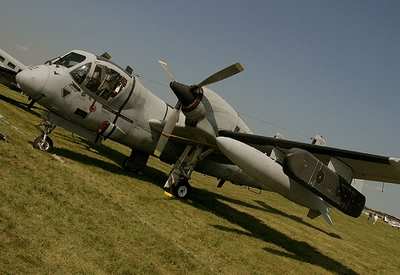By ANN Correspondent Rob Milford
One of the truly unique warbirds on the line at Whitman Field
this year is the RV-1D Mohawk, the last-of-the-line version of the
unsung reconnaissance hero of Vietnam, the Cold War, and Desert
Storm.

Operated by The American Wings Air Museum in Blaine, Minnesota,
it looks ready to take on yet another low-level electronic recon
mission, or perform a radar surveillance of terrain “over the
fence” (which is spy talk for enemy territory).
“We have three flyable, and two more in restoration”
says Ed Finnegan “We’re pretty much Mohawk
Central”. There are about a dozen Mohawk aircraft
operating around the country. Finnegan should know. He spent his
entire Army career in the left seat of the Grumman built aircraft.
Getting shot at over the Korean peninsula, and zigging and zagging
along the inter-German border as they performed threat evaluation
missions. He has over 1,200 hours PIC in his logbook.

The aircraft crew chief is Joe “Pineapple” Aragon,
who started working on the aircraft in 1962, when he was assigned
to the 11th Air Assault Division at Ft.Benning, Georgia. The
retired tool and die maker says he was out mowing the lawn in
1994when he heard the sound of a Mohawk flying over, then spotted
his old love. He shut off the mower, went inside the house, grabbed
the car keys and told his wife he was off to “follow the
airplane” and was driving down the street before he got an
answer. Since then, he’s been one of the lead mechanics,
along with a crew chief who handled the initial Navy and Marine
Corp testing of the aircraft at NAS Pataxuet River in 1962.
“We’re all volunteers” Aragon says “Guys
spend their weekends in the hanger, doing all the work…
it’s great fun”.
Finnegan supports his old airplane habit by driving
Fokker-100’s for American Airlines at Chicago O’Hare
(ORD). From the shadow of the bug-eyed cockpit, he says
“This is one amazing aircraft… not forgiving of any
inattention, and sometimes, pretty challenging to fly”.
Power is never an issue “We have 1,400 horsepower on each
side, and if, by some chance there’s an engine failure, you
just smash on the rudder and keep it there”. With the live
Martin-Baker ejection seats, Finnegan says they try to keep the
aircraft as authentic as possible. It’s a fully aerobatic
aircraft, and when asked why they have a triple tail, Finnegan
answers simply “Torque…there’s an awful lot of
torque”
“They call us a crowd magnet” the 40-something
Finnegan says, “Joe and I hang out with the aircraft, talking
with people, answering their questions, and meeting lots of old
Mohawk pilots and ground crew”. While we were talking on
Monday morning, several people came up with their own Mohawk
stories, and connections, including one man who was bringing a
friend of his to the show later this week, who flew Mohawks in
Vietnam.

The deployment to Vietnam is another untold story. Says Aragon
“We would fly them over, trans-Atlantic, with 300 gallon drop
tanks under each wing, plus more than 800 internal gallons, and
that would still make for a 13 hour leg between Newfoundland and
the Azores” The option was taking about two months to
“pickle” the aircraft, wrap it up, and put it on a
ship. The Army could fly them over in about two weeks.
To visit the museum -- Anoka County-Blaine Airport (Janes Field)
locator: ANE, just north of Minneapolis.
 ANN's Daily Aero-Term (12.04.25): Cooperative Surveillance
ANN's Daily Aero-Term (12.04.25): Cooperative Surveillance ANN's Daily Aero-Linx (12.04.25)
ANN's Daily Aero-Linx (12.04.25) NTSB Prelim: Extra Flugzeugproduktions EA 300/SC
NTSB Prelim: Extra Flugzeugproduktions EA 300/SC Classic Aero-TV: The Bally Bomber - The All Time Ultimate Warbird Replica?
Classic Aero-TV: The Bally Bomber - The All Time Ultimate Warbird Replica? ANN's Daily Aero-Linx (12.05.25)
ANN's Daily Aero-Linx (12.05.25)





